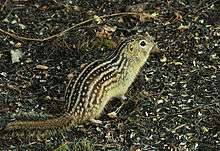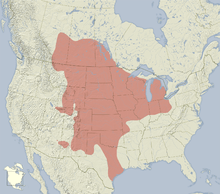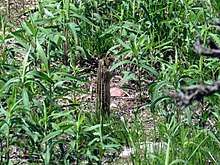Thirteen-lined ground squirrel
The thirteen-lined ground squirrel (Ictidomys tridecemlineatus), also known as the striped gopher, leopard ground squirrel, squinney, (formerly known as the leopard-spermophile in the age of Audubon), is a ground squirrel that is widely distributed over grasslands and prairies of North America.
| Thirteen-lined ground squirrel | |
|---|---|
 | |
| Scientific classification | |
| Kingdom: | Animalia |
| Phylum: | Chordata |
| Class: | Mammalia |
| Order: | Rodentia |
| Family: | Sciuridae |
| Genus: | Ictidomys |
| Species: | I. tridecemlineatus |
| Binomial name | |
| Ictidomys tridecemlineatus (Mitchill, 1821) | |
 | |
| Synonyms | |
|
Spermophilus tridecemlineatus | |
Description

It is brownish, with 13 alternating brown and whitish longitudinal lines (sometimes partially broken into spots) on its back and sides, creating rows of whitish spots within dark lines.
| Biological statistics | |
|---|---|
| Length | 6¾–11⅝ inches (170–297 mm) |
| Tail | 2⅜–5¼ inches (60–132 mm) |
| Head | 1–1⅝ inches (27–41 mm) |
| Weight | 3⅞–9½ oz (110–270 g) |
Taxonomy
This species has usually been placed in the genus Spermophilus with about 40 other species. As this large genus is paraphyletic to prairie dogs, marmots, and antelope squirrels, Kristofer Helgen and colleagues have split it into eight genera, placing the thirteen-lined ground squirrel in Ictidomys with two other species.[2]
Behavior
The thirteen-lined ground squirrel is strictly diurnal and is especially active on warm days. A solitary or only somewhat colonial hibernator, it often occurs in aggregations in suitable habitats.
In late summer, it puts on a heavy layer of fat and stores some food in its burrow. It enters its nest in October (some adults retire much earlier), rolls into a stiff ball, and decreases its respiration from between 100 and 200 breaths per minute to one breath about every five minutes. It emerges in March or early April.
The burrow may be 15 to 20 feet (4.6 to 6.1 metres) long, with several side passages. Most of the burrow is within one to two feet (about half a meter) of the surface, with only the hibernation nest in a special deeper section. Shorter burrows are dug as hiding places. This ground squirrel's home range is two to three acres (0.8 to 1.2 ha).


Its primary diet includes grass and weed seeds, caterpillars, grasshoppers, and crickets, but it may also eat mice and shrews; it will viciously attack and consume cicadas if able to catch them. This squirrel sometimes damages gardens by digging burrows and eating vegetables, but also devours weed seeds and harmful insects.
It is well known for standing upright to survey its domain, diving down into its burrow when it senses danger, then sometimes poking out its nose and giving a bird-like trill. It has a maximum running speed of 8 mph (13 km/h) and reverses direction if chased.
See also
- Golden-mantled ground squirrel
- Chipmunk an animal with a similar appearance of stripes
References
- Linzey, A. V. & Hammerson, G. (2008). "Spermophilus tridecemlineatus". IUCN Red List of Threatened Species. 2008. Retrieved 8 January 2009.CS1 maint: ref=harv (link)
- Helgen, Kristofer M.; Cole, F. Russel; Helgen, Lauren E. & Wilson, Don E (2009). "Generic Revision in the Holarctic Ground Squirrel Genus Spermophilus" (PDF). Journal of Mammalogy. 90 (2): 270–305. doi:10.1644/07-MAMM-A-309.1. Archived from the original (PDF) on 22 October 2011.
External links
| Wikimedia Commons has media related to Ictidomys tridecemlineatus. |
- Thirteen-lined Ground Squirrel Genome Project page at GenBank
- If you know what a 'squinny' is, you're probably from Des Moines
- "Spermophilus tridecemlineatus". Integrated Taxonomic Information System. Retrieved 5 November 2010.
- View the squirrel genome in Ensembl
- View the speTri2 genome assembly in the UCSC Genome Browser.
